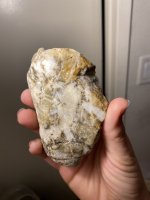scrounger d detector collector
Bronze Member
- Aug 27, 2006
- 1,643
- 3
- Detector(s) used
- MINELAB E TRAC, EXCAL2,QUATTRO,WHITE 6000 DI PRO SL,EAGLE SPECTRUM,SILVER UMAX ,BANDIDO UMAX VARIOUS VINTAGE
well its been mighty tuff this year what with titanium,steel
and others found.
i try and keep up with current trends and here from a
recent jewelry catalog. comes
ARGENTUIM SILVER WHICH I GUESS IS BETTER
THAN sterling reduced copper content.
HONEYDIUM- A RICH HONEY COLORED blend of metals
w over 50 per cent silver. dont say what the other metals are.-
VALADIUM NO INFO ON
just when i thought i was learning about jewelry
now this ugh
and others found.
i try and keep up with current trends and here from a
recent jewelry catalog. comes
ARGENTUIM SILVER WHICH I GUESS IS BETTER
THAN sterling reduced copper content.
HONEYDIUM- A RICH HONEY COLORED blend of metals
w over 50 per cent silver. dont say what the other metals are.-
VALADIUM NO INFO ON
just when i thought i was learning about jewelry
now this ugh
Amazon Forum Fav 👍
Upvote
0



